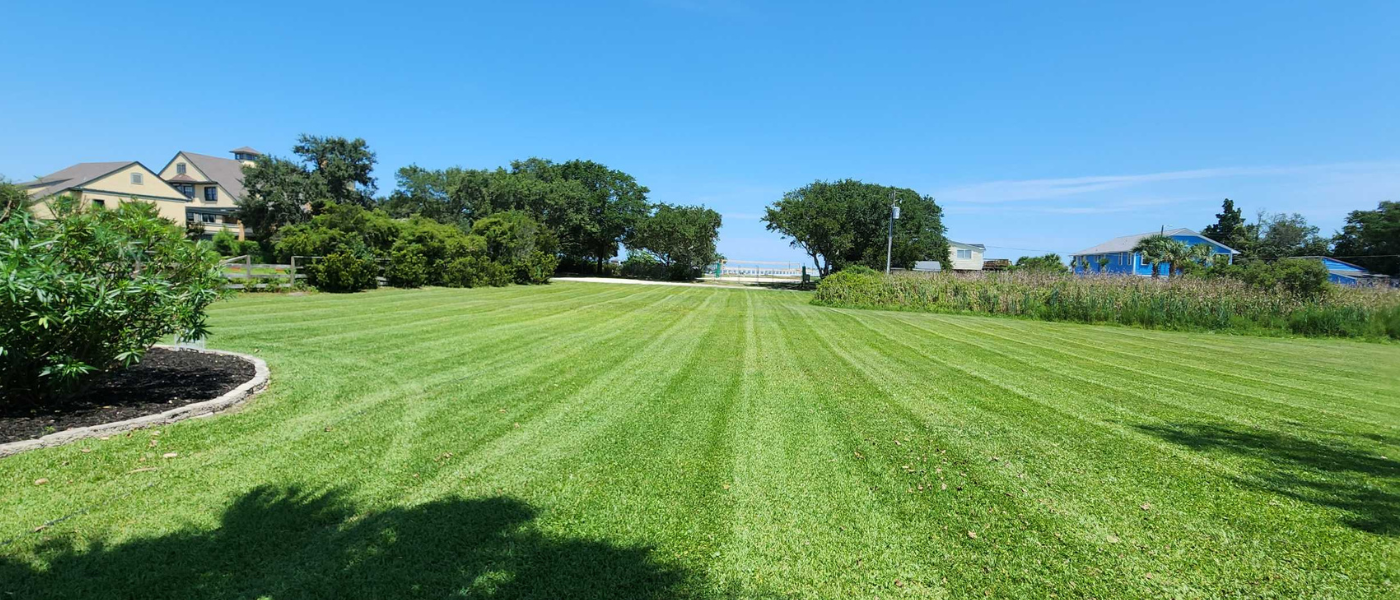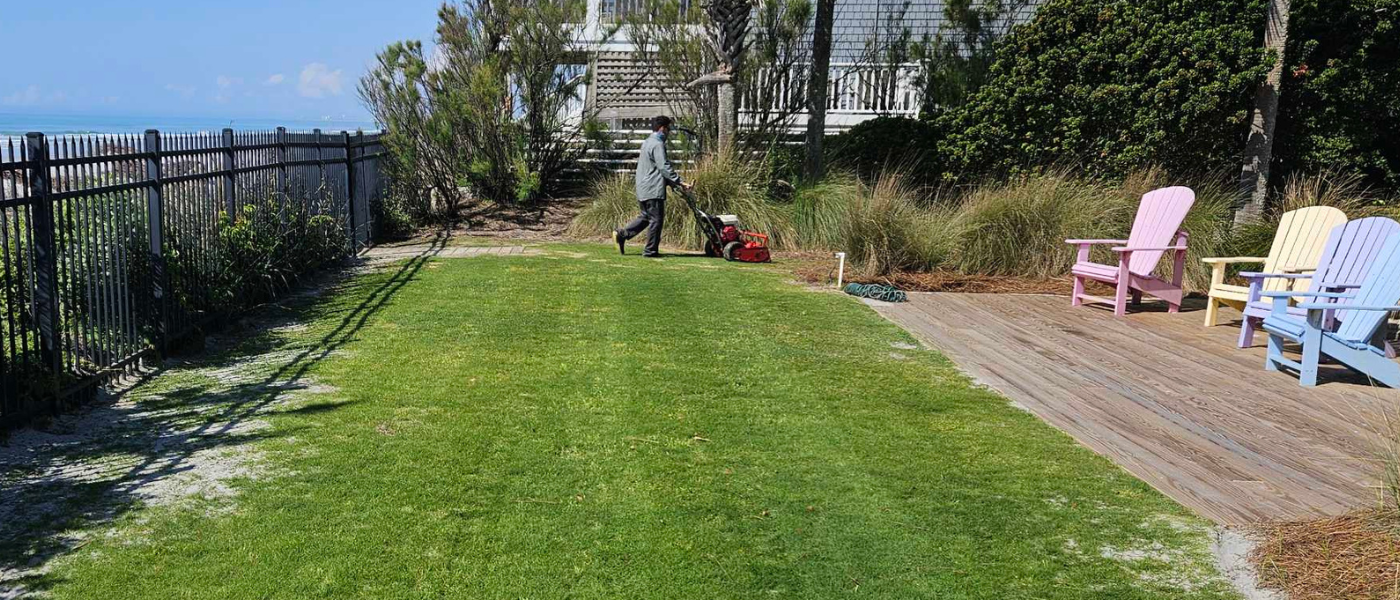Warm Season Grasses in Wilmington, NC: Choosing, Growing, and Maintaining Your Perfect Lawn
Warm season grass selection, care, and maintenance in Wilmington, NC, are explored in this comprehensive guide, offering insights into choosing the right type for your lawn based on climate adaptability, usage needs, and aesthetic goals.
Welcome to Wilmington, southeastern North Carolina, a haven for warm-season grasses! At Vinedresser Lawn and Landscape, we’re here to guide you through selecting, caring for, and flourishing your lawn with the right type of grass. Our aim? We aim to arm you with the knowledge to choose the best grass for your home, considering maintenance needs and our unique local climate.
Embarking on your lawn journey, we’ll lean on insights from the NC State publication “Carolina Lawns: A Guide to Maintaining Quality Turf in the Landscape.” This guide will be our roadmap to understanding our area’s intricacies of warm-season grasses.
Our goal is simple: to help you navigate the options, understand care requirements, and make informed decisions for a lush, vibrant lawn. Let’s dive into the world of warm-season grasses together, crafting green spaces that bring life to our homes and community.
Grass Type | Ideal Conditions | Growth Rate | Maintenance Needs | Mowing Recommendations | Seeding or Sodding |
Bermuda | Full sun, high traffic | Rapid | Frequent mowing, fertilization | 1-1.5 inches, weekly, with reel mower | Easier to seed; high-quality seed essential |
Zoysia | Sun and light shade | Slow | Less frequent mowing | 1-2 inches, every 1-2 weeks, reel or rotary mower for different textures | Challenging to seed; correct seed crucial |
Centipede | Acidic soils, partial shade | Slow | Low, infrequent mowing, minimal fertilization | 1.5-2 inches, every 1-2 weeks, rotary mower | Prefers sodding or vegetative planting |
St. Augustine | Shade, coastal areas | Fast | More water and care | 2.5-4 inches, weekly rotary mower | Prefers sodding due to seed availability |
Carpet | Wet, shaded areas | Low | Low, tolerates less mowing | 2-3 inches, every 1-2 weeks, rotary mower | Sodding or vegetative planting recommended |
Bahia | Utility areas, drought-resistant | Varied | Regular cutting for seed heads | 3-4 inches, every 1-2 weeks, rotary mower | Suitable for seeding; maintenance for utility use |
Deciding What to Plant
Selecting the ideal grass type is a pivotal decision for any lawn, whether you’re embarking on a new lawn project or considering renovating your current green space. Here’s why it’s so important:
- Adaptation to Local Climate: The grass you choose must thrive in Wilmington’s specific weather conditions.
- Usage Needs: Consider how your lawn will be used. Will it endure heavy foot traffic, or is it mainly for aesthetic appeal?
- Tolerance to Wear: Different grasses have varying levels of resilience to wear and tear.
- Aesthetic Goals: Your vision for your lawn’s appearance is crucial in selecting.
In southeastern North Carolina, especially Wilmington, warm-season grasses emerge as the prime candidates for several reasons:
- Climate Compatibility: These grasses excel in our warm, humid environment.
- Durability: Warm-season varieties are known for their ability to withstand heat and drought.
- Visual Appeal: They offer a range of textures and colors to match any landscaping vision.
Choosing the right grass means aligning these factors with your specific needs and aspirations for your lawn. Let’s navigate this process together, ensuring your lawn grows and thrives in its environment.
Overview of Warm Season Grasses
Warm-season grasses are the foundation of vibrant, green lawns throughout southeastern North Carolina, including Wilmington. These grasses are perfectly suited to our hot summers and mild winters. Here’s a closer look at the types available and their key characteristics:
Types of Warm Season Grasses
- Bermuda Grass: Known for its resilience and rapid growth, Bermuda thrives in full sun. It’s a top choice for high-traffic areas, thanks to its ability to quickly recover from wear.
- Zoysia Grass: It offers a dense, soft texture and is known for its tolerance to wear, making it suitable for sunny and lightly shaded areas. Its slower growth rate means less frequent mowing.
- Centipede Grass: This low-maintenance option is ideal for acidic soils and can tolerate partial shade. However, it does not handle foot traffic well and has specific soil pH requirements.
- St. Augustine Grass: Valued for its shade and salt tolerance, St. Augustine is great for coastal areas but requires more water and care to maintain its lush appearance.
- Carpet Grass: Like centipede grass, carpet grass is a low-growing, medium-green option that excels in wet, shaded environments. It’s low maintenance but does not tolerate cold, drought, or heavy traffic well.
- Bahia Grass: Tough and drought-resistant, Bahia is less commonly used for residential lawns due to its open canopy and unsightly seed heads but is excellent for utility areas.

Soil Temperature’s Impact on Growth
Soil temperature plays a critical role in the lifecycle of warm-season grasses. Here’s how:
- Spring Activation: Warm-season grasses typically begin to grow when soil temperatures consistently reach about 65°F (18°C). This temperature signals the grass that it’s time to break dormancy and start new growth.
- Summer Vigor: Throughout the summer, as soil temperatures rise, these grasses enter their most active growth phase. This is when they need ample nutrients and water to support their rapid development.
- Fall Slowdown: As soil temperatures cool in the fall, growth slows, leading to the dormancy phase. This natural cycle is crucial for the grass to conserve energy over the winter months.
Understanding these aspects of warm-season grasses can help you make informed decisions about lawn care, ensuring your grass remains healthy and vibrant throughout its growing season. Whether you’re establishing a new lawn or maintaining an existing one, recognizing the specific needs and characteristics of your chosen grass type will lead to better lawn health and appearance.
Detailed Analysis and Care Recommendations for Each Warm-Season Grass Type
Selecting the right warm-season grass for your southeastern North Carolina lawn means considering each type’s unique traits and care requirements. Here’s a detailed look at each, including mowing recommendations to ensure your lawn stays healthy and attractive.
Bermuda Grass
- Growth & Traits: Fast-spreading through stolons and rhizomes, Bermuda grass is drought-tolerant and thrives in sandy soil.
- Maintenance: It needs frequent, low mowing to stay dense and healthy. For best results, use a reel mower to mow to a height of 1-1.5 inches.
- Mowing Frequency & Equipment: At least once a week during the growing season, with a sharp reel mower to encourage a lush, carpet-like appearance.
Zoysia Grass
- Growth & Traits: Dense and wear-tolerant, Zoysia is suitable for sun and light shade but grows slowly.
- Maintenance: Requires less frequent mowing due to its growth rate. Mow to a height of 1-2 inches with a reel mower for fine-textured varieties or a rotary mower for coarser types.
- Mowing Frequency & Equipment: Every week, depending on growth speed and desired lawn appearance. Sharp blades are crucial for a clean cut.
Centipede Grass
- Growth & Traits: Known for slow growth and low maintenance needs, it’s ideal for acidic soils and tolerates partial shade.
- Maintenance: Prefers infrequent mowing. Mow to a height of 1.5-2 inches with a rotary mower.
- Mowing Frequency & Equipment: Every week, ensure not to remove more than one-third of the blade height at a time to avoid stressing the grass.
St. Augustine Grass
- Growth & Traits: Fast-growing and shade-tolerant, it’s suitable for coastal areas but sensitive to cold and traffic.
- Maintenance: To maintain health, it needs to be mowed at a higher height. Use a rotary mower to mow to a height of 2.5-4 inches.
- Mowing Frequency & Equipment: Weekly mowing is recommended during the peak growth season to keep it tidy and stress-free.
Carpet Grass
- Growth & Traits: Thrives in wet, shaded areas with a medium-green color: low-growing and low maintenance.
- Maintenance: It is less demanding in terms of mowing. Use a rotary mower to mow to a height of 2-3 inches.
- Mowing Frequency & Equipment: Every 1-2 weeks or as needed to maintain the desired appearance without putting too much stress on the grass.
Bahia Grass
- Growth & Traits: With an open canopy and noticeable seed heads, Bahia is tough but offers a less manicured look.
- Maintenance: Tolerates a range of mowing heights but requires regular cutting to control seed heads. Mow to a height of 3-4 inches with a rotary mower.
- Mowing Frequency & Equipment: Every 1-2 weeks to keep seed heads at bay and maintain a uniform appearance.

Importance of Regular Mowing
Regular mowing is not just about keeping your lawn looking its best; it also plays a crucial role in its health and vigor. Consistent mowing:
- Encourages denser growth, reducing weed competition.
- Helps the grass maintain its ideal height, promoting better stress tolerance.
- Allows for the even distribution of resources like sunlight and water.
By understanding and implementing the right mowing practices for your chosen grass type, you can significantly impact the appearance and health of your lawn, ensuring it remains a beautiful and resilient part of your outdoor living space.
Sodding and Seeding Warm Season Grasses
Establishing a lush, vibrant lawn in southeastern North Carolina comes with its unique set of challenges and considerations, especially when it comes to seeding warm season grasses.
Challenges with Seeding
Warm season grasses often present difficulties in seeding due to their specific growth patterns and environmental needs. Many varieties have a slow germination process and require specific soil temperatures and conditions to successfully establish. Additionally, finding the correct seed type for Bermuda and Zoysia grasses can be particularly problematic.
Preference for Sodding or Vegetative Planting
For most warm season grass types, sodding or vegetative planting is preferred over seeding. These methods provide immediate coverage and are generally more reliable for establishing a healthy lawn. Sodding eliminates the uncertainty of seed germination and can offer a mature lawn appearance much quicker.
Specific Seeding Recommendations
For those who choose to seed, particular care should be taken with Bermuda and Zoysia grasses:
- Bermuda Grass: This grass can be seeded relatively easily compared to other warm-season types. The challenge lies in sourcing high-quality seed that matches the desired lawn characteristics. It requires warm soil temperatures and consistent moisture to germinate. Seeding Bermuda grass is best done in late spring or early summer.
- Zoysia Grass: Zoysia is more challenging to seed due to its slower germination and growth rate. Like Bermuda, selecting the correct Zoysia seed is crucial for successful lawn establishment. For best results, seed in late spring when soil temperatures are consistently warm. Keep the seeded area moist until germination and establishment.
Conclusion:
In Wilmington, NC, and the broader southeastern region, homeowners have a variety of warm-season grasses to choose from, each with its own set of benefits and care requirements. Whether you’re leaning towards the rapid spread of Bermuda, the dense turf of Zoysia, the low maintenance of Centipede, the shade tolerance of St. Augustine, or the ruggedness of Bahia and Carpet grasses, selecting the right type is critical. Consider your lawn’s specific needs, environmental conditions, and your personal preferences to make the best choice.
Establishing and maintaining a beautiful lawn is a rewarding venture that enhances your home’s appearance and your outdoor experience. Remember, whether you opt for seeding, sodding, or vegetative planting, the key to a successful lawn lies in understanding the unique characteristics and needs of your chosen grass type.
We hope this guide has provided valuable insights into selecting and caring for your warm season lawn. If you have any questions or need further assistance, don’t hesitate to reach out. We’re here to help you achieve the lush, green lawn of your dreams!
